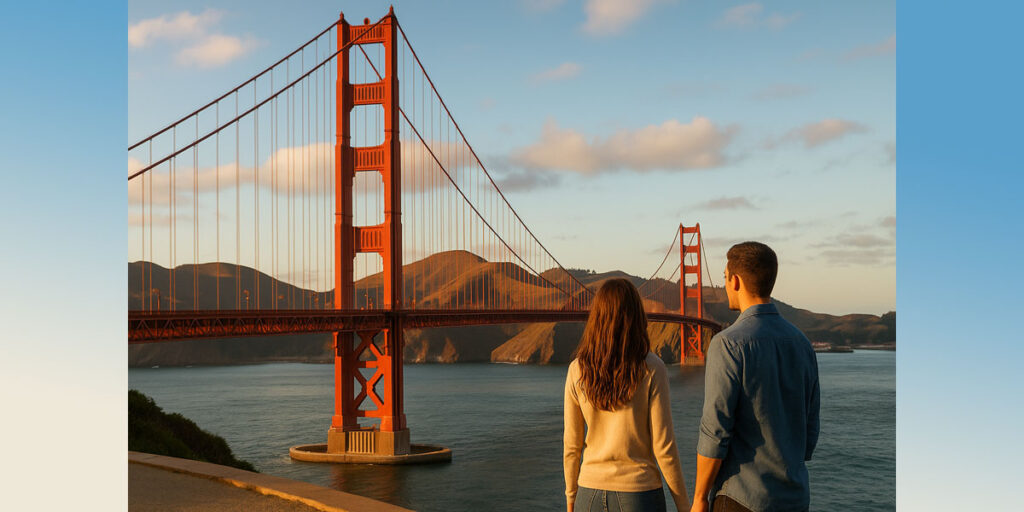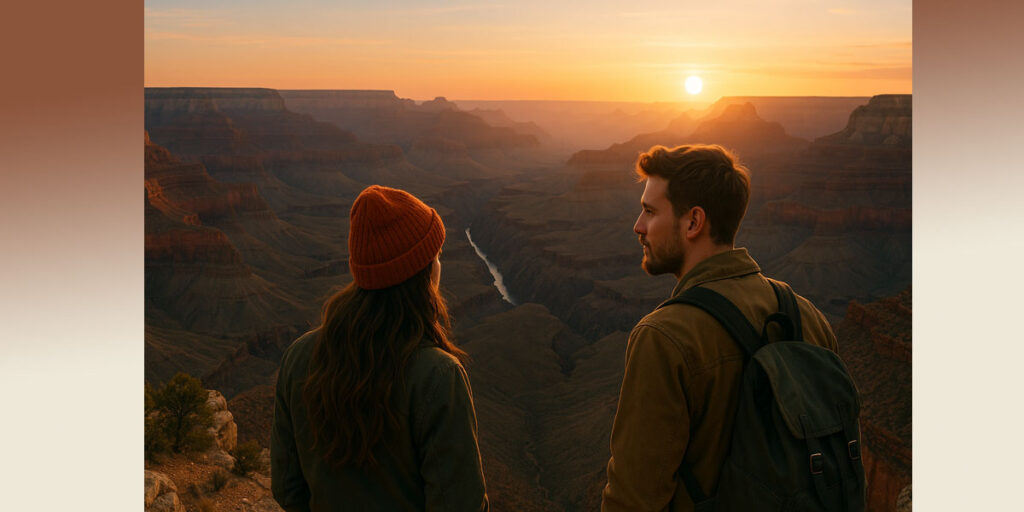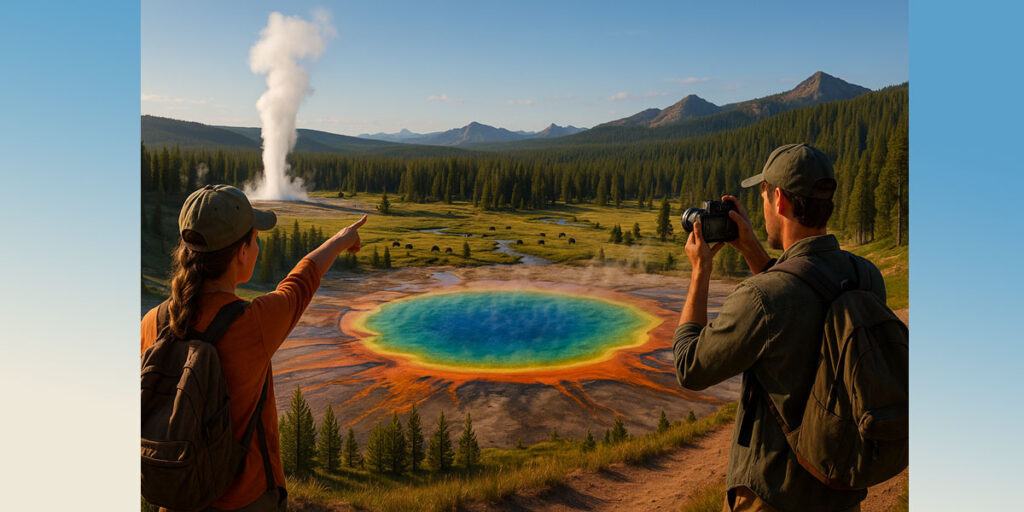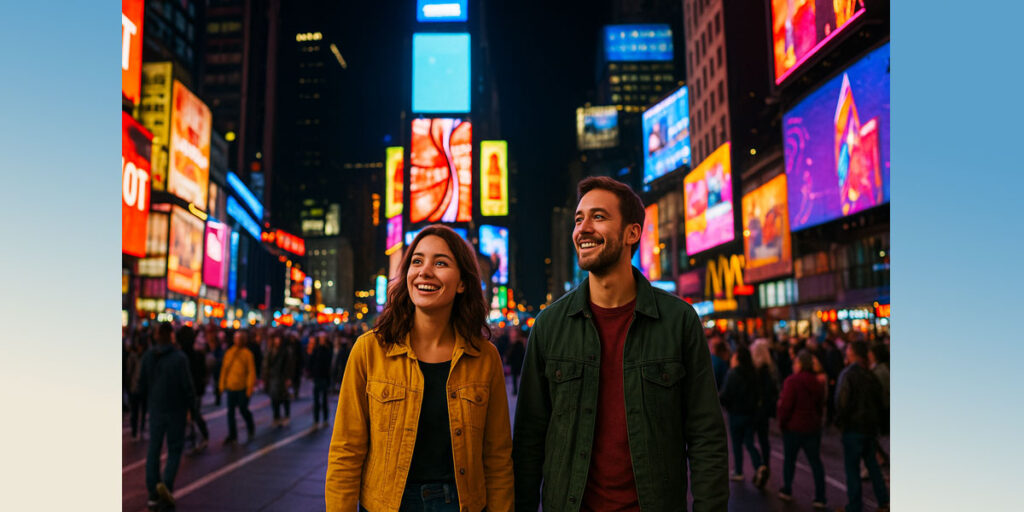Q1: Have you ever wondered why the Golden Gate Bridge isn’t actually golden?
Ah, the story of its color is as intriguing as the bridge itself! Back in the 1930s, when the Golden Gate Bridge was being built, the original plan was to paint it gray or black. However, the bridge’s architect, Irving Morrow, noticed the striking reddish-orange primer coating used to protect the steel beams. Captivated by how this vibrant hue contrasted beautifully with the blues and greens of the San Francisco Bay, he advocated strongly for this unusual choice. The shade, known officially as “International Orange,” not only gave the bridge its iconic status but also provided visibility through the region’s notorious fog. Today, when you see the bridge cloaked mysteriously in fog, you’ll understand the genius behind its color choice.
Q2: What makes the Golden Gate such a special location geographically?
The Golden Gate Bridge spans one of the most dramatic entrances from the vast Pacific Ocean into the sheltered waters of San Francisco Bay—a strait aptly named the “Golden Gate.” Geographically speaking, this narrow waterway is just over a mile wide, connecting the roaring Pacific with calm, deep waters within the bay. The fierce currents and strong tides here challenged engineers during construction in the 1930s. Surrounding the strait are steep cliffs, rugged hills, and breathtaking views, giving visitors spectacular vistas of the ocean, bay islands like Alcatraz, and the city skyline. Standing on the bridge, gazing out at the endless horizon, you can feel the magic of nature meeting human ingenuity.
Q3: When is the perfect time to visit this magnificent bridge?
Visiting the Golden Gate Bridge is an enchanting experience at almost any time, but mornings and sunsets are especially magical. Early morning, when the bridge emerges gently from the famous San Francisco fog, feels like watching a masterpiece slowly being unveiled. As the fog dissipates, usually by midday, the bridge gleams vibrantly under the California sun. Late afternoon and sunset visits offer an entirely different charm. The sky bursts into spectacular shades of orange, purple, and gold, casting the iconic orange towers into dramatic silhouettes. For the clearest weather and optimal viewing, September and October are considered ideal months to experience the Golden Gate Bridge in all its magnificent glory.
Q4: How did the builders triumph over roaring currents and fierce winds?
Imagine standing atop a cliff, feeling the powerful winds that whip across the Golden Gate strait. In the early 1930s, Chief Engineer Joseph Strauss and his team had to devise daring solutions. They anchored massive floating barges in swirling currents and erected towering caisson foundations on the seabed. Workers braved winds exceeding 70 miles per hour, suspending themselves hundreds of feet above the water on swinging scaffolds. Safety nets—nicknamed “Halfway-to-Hell”—saved 19 men, turning tragedy into triumph. By 1937, these audacious feats of engineering had tamed nature’s fury, gifting the world a bridge that seems to float majestically above the bay.
Q5: What hidden stories lie in the bridge’s sweeping length?
Stretching 1.7 miles from end to end, the Golden Gate Bridge was the longest suspension span in the world until 1964. Each of its two main cables consists of 27,572 individual wires—enough to circle the globe more than three times! Beneath its graceful curves, shipping vessels pass daily, their tiny silhouettes revealing the bridge’s monumental scale. On foggy mornings, the roadway disappears into clouds, leaving only the twin towers visible like sentinels guarding an otherworldly crossing. Every step across those 8-foot-wide sidewalks brings you closer to the pulse of the bay and a sense of walking through living history.
Q6: When should you plan your walk or ride to feel most alive?
The bridge sidewalks open at sunrise and close at sunset, inviting explorers to traverse its span on foot or by bike. For an invigorating experience, aim for early spring mornings—when the brisk air sharpens your senses and the bay glistens beneath a pastel sky. Cyclists relish weekdays before 10 AM, when the path is quieter and the breeze cools the exertion of pedaling up gentle inclines. As daylight wanes, plan your crossing in late afternoon; you’ll witness the day’s final light dancing on the water and the towers bathed in a warm glow before the lights come on for the night. Remember to check seasonal schedules—during winter months, the bridge may close temporarily for high winds—so you can time your adventure to perfection.
Q7: What role did the Golden Gate Bridge play during World War II?
In the shadow of global conflict, the Golden Gate Bridge stood as more than a marvel of architecture—it became a vital strategic asset. During World War II, military convoys navigated beneath its arches en route to protect the Pacific coastline, while anti-submarine nets were stationed near the bridge’s piers to guard against potential enemy incursions. At night, the bridge’s lights were dimmed to comply with blackout regulations, turning its bold silhouette into a dark monolith against the bay. Today, when you stand atop the bridge and feel the vibrations beneath your feet, you’re touching a site that once served as a guardian of the nation’s western gateway.
Q8: How does the Bay’s famous fog shape a visitor’s experience?
Gentle tendrils of fog—affectionately known as “Karl the Fog”—roll in from the Pacific, weaving through the bridge’s towers and cloaking the roadway in ethereal mist. Geographically, the strait’s narrow channel funnels cool ocean air under the Golden Gate’s ridge, causing condensation that births this signature weather. Walk out onto the span on a foggy morning, and you’ll see only the top third of the towers, as if they’re peeking through a cloud. It’s a moment of pure wonder that photographers chase and poets immortalize, a reminder that nature has the power to transform steel into dreamlike scenery.
Q9: Can you join in the annual Bridge Walk for a truly memorable visit?
Every May, thousands gather on the bridge for the annual “Walk the Golden Gate” event, celebrating the spirit of San Francisco with every step. Registration opens months in advance, and participants—young and old—wind along the east sidewalk at sunrise, cheered on by volunteers offering water and local snacks. The brisk morning air, the shimmer of the bay below, and the camaraderie of fellow walkers create an atmosphere unlike any other. Whether you’re a lifelong resident or a first-time tourist, timing your visit to coincide with this festive tradition ensures you experience the bridge not just as a sight to behold, but as a living thread in the city’s vibrant tapestry.
Q10: How has the Golden Gate Bridge stayed safe and stunning through the decades?
The bridge you admire today isn’t exactly the same one from 1937—it’s been continually cared for through one of the world’s most ambitious maintenance programs. Painters work year-round in swinging cradles, applying fresh coats of International Orange to guard against rust and salt spray. Seismic retrofits, completed in stages over recent decades, have reinforced its towers and anchorage to withstand major earthquakes that could rattle the Bay Area. Whenever you visit, pause to watch the crews at work—each brushstroke and steel upgrade is a chapter in the bridge’s ongoing tale of resilience.
Q11: Where can you capture the most breathtaking vistas of the bridge?
Though walking across has its own magic, some hidden vantage points make you feel like you’ve stepped into a postcard. Head to the Marin Headlands just north of the span in the late afternoon: winding trails lead to Battery Spencer, where you can gaze across the strait at the bridge rising like a monarch’s crown above the water. On the southern side, Fort Point—nestled at the base of the south tower—invites you to explore its brick arches and then tilt your head upward for an awe-inspiring perspective. Aim to arrive 30 minutes before sunset to set up your camera, when the warm light bathes the towers in golden hues and casts long shadows across the bay.
Q12: What’s the secret sunrise ritual for early-bird visitors?
Long before the city awakens, dedicated photographers and joggers gather at Crissy Field, just east of the bridge, trading sleepy greetings as the first light peaks over the Pacific. As the sun edges above the horizon, its rays pierce through the towers, igniting them in a soft glow that gradually intensifies. This is the bridge’s quietest hour—no traffic hums, no crowds block the view, just the hush of the morning tide and the bridge silhouette against a sky painted in pink and gold. Pack a thermos of coffee, wrap up against the chill, and you’ll understand why locals swear this sunrise pilgrimage is the soul-stirring way to start any day in San Francisco.
Q13: What spectacular light shows illuminate the bridge after dark?
Though the Golden Gate Bridge is usually seen in daylight, special occasions transform it into a glowing beacon. On significant anniversaries—like its 75th in 2012—or during the annual Fleet Week, the towers and cables are festooned with festive lights. This tradition began in the 1980s, adding strings of white bulbs that outline the suspension cables against the night sky. Arrive at the nearby Marina Green or Fort Point around dusk, and you’ll witness the bridge’s profile light up in celebration, reflecting in the bay’s calm waters. Remember to check the event calendar, because these radiant displays only happen a few times a year.
Q14: Which nearby trails reveal hidden geographic wonders?
Beyond simply crossing the bridge, the surrounding parklands offer trails that showcase the region’s geology and wildlife. On the north side, the Batteries to Bluffs Trail hugs the rugged cliffs, winding past historic coastal defense batteries from World War II and giving panoramic views of the Marin Headlands. Look down to see crashing surf carving sea caves and listen for peregrine falcons nesting on the rocky outcrops. On the Presidio side, the Ecology Trail immerses you in eucalyptus groves and coastal scrub, opening onto vistas where you can spot Alcatraz Island in the mist. Both paths provide a deeper connection to the landscape that dictated where and how the Golden Gate Bridge would rise.
Q15: How does the bridge’s experience change with the seasons?
Each season brings its own mood to the bridge. Winters (December–February) are cool and breezy, with frequent fog banks that obscure the deck but reveal only the tips of the towers—an enchanting, otherworldly scene best viewed at midday when the fog layer is lowest. Spring awakens wildflowers on the hillsides, painting the slopes in gold and purple; mornings are crisp and clear, ideal for a sunrise walk. Summer (June–August) often greets visitors with heavy fog—known as “June Gloom”—that mellows by afternoon, so plan your visit after 2 PM for the clearest vistas. Autumn (September–November) delivers the best weather: warm, dry days and minimal fog make it prime time for walking, cycling, or photographing the bridge in glorious, unobstructed light.
Q16: Why do you sometimes see workers dangling like dancers from the towers?
High above the bay, you might glimpse maintenance crews rhythmically swinging in bosun’s chairs, repainting and inspecting the bridge’s steel. These “bridge ballet” performances occur year-round to fend off corrosion from salty sea spray and shifting temperatures. Each worker—secured by harness and cable—blends precision and artistry, touching up spots as small as a penny or as large as a door. If your visit coincides with a clear weekday morning, pause mid-span to watch their choreographed routines: it’s a live testament to human dedication keeping this treasured landmark safe and shining.
Q17: How do the tides and marine life shape your view from the bridge?
Looking down through the safety grates at low tide reveals a hidden world of rocky shores, kelp forests, and sea stars clinging to barnacle-covered pilings. At high tide, you may spot harbor seals bobbing playfully in the currents or California sea lions hauled out on nearby breakwaters. Seasonal whale migrations sometimes bring gray whales gliding serenely beneath the cables in spring, and humpbacks breaching farther off in summer. Timing your walk with tidal charts—available online—lets you experience the bridge not just as a structure of steel but as a window to the vibrant ecosystems thriving below.
Q18: Which annual events can turn your bridge visit into a grand celebration?
Every July, the San Francisco Marathon routes thousands of runners across the Golden Gate Bridge, their colorful bibs a moving mosaic against the International Orange towers. In October, the “Light the Bridge” charity run invites participants to don glow-in-the-dark gear and cross the span under luminescent arches. And each New Year’s Eve, spectators gather on the north overlooks to watch fireworks launched from barges beneath the bridge, the night sky alight in prismatic bursts. Check event schedules early—many races and festivals require advance registration—and plan your trip to join in the festive energy that transforms a simple crossing into a momentous occasion.
Q19: What secrets hide in the toll plaza’s ebb and flow?
As you approach the bridge from San Francisco, you’ll pass through the toll plaza where millions of vehicles have traversed since tolling began in 1937. Originally, drivers handed coins to toll collectors seated in small booths surrounded by steel bars. Today, FasTrak electronic tolling whisks cars through at highway speeds—yet you can still glimpse the original tollhouses, now preserved as quaint reminders of the past. On busy summer weekends, the ebb and flow of traffic becomes a ballet of brake lights and green arrows, a modern choreography that sustains the bridge’s financial heartbeat.
Q20: How does the Golden Gate Bridge inspire art and culture?
Over the decades, artists, filmmakers, and writers have found muse in the bridge’s bold silhouette. Ansel Adams captured its dramatic contrast against swirling fog in monochrome photographs that became icons of American landscape art. Alfred Hitchcock turned its towering spires into suspense in “Vertigo,” while contemporary muralists have painted nearby walls in vibrant tributes to its arches. Each sunrise or sunset becomes a live canvas, inspiring sketchpads and camera lenses alike. If you pause on the eastern sidewalk, you might spot local painters at easels, translating the bridge’s grandeur into strokes of color.
Q21: Where can you learn more before you set foot on the span?
Before crossing, consider stopping at the Golden Gate Welcome Center on the San Francisco side. Inside, interactive exhibits recount the bridge’s daring construction through historic photographs, salvaged steel artifacts, and personal stories of the workers. A viewing deck there offers binoculars keyed to points of interest—like the rust-red anchorages and the foghorns perched atop the towers. Admission is free, and volunteer docents are eager to share anecdotes about near-miss safety rescues and the bridge’s role in pop culture. Equipped with these tales, every step you take across the Golden Gate becomes richer with history and human spirit.
Q22: How did funding this audacious project become a story in itself?
When the Golden Gate Bridge was proposed, investors balked at its $35 million price tag—roughly $700 million today. Bay Area banker Charles Strauss (no relation to the engineer) rallied local bond sales by pitching the bridge as a symbol of progress during the Great Depression. In shimmering community halls, he shared artist renderings of the sleek span arching over sapphire waters, convincing skeptical citizens to invest their savings. By 1935, voter-approved bonds sealed the deal. Each car passing today still carries a piece of that communal vision, a reminder that big dreams often need bold believers.
Q23: Where can you catch the bridge bathed in moonlight?
On clear full-moon nights, the Silver Gate legend comes alive. Head to Kirby Cove, a hidden sandy inlet below the Marin Headlands—accessible via a short, leaf-strewn trail—and set out a blanket beneath swaying cypress trees. As the moon rises over the Pacific, its silvery glow turns the water into molten glass and the bridge’s towers into muted silhouettes. Few tourists venture this way late at night, so you’ll likely share the moment only with nocturnal crickets and distant foghorns. It’s a hush-filled, almost mystical experience that transforms the familiar span into a lunar cathedral.
Q24: How does the bridge’s design respect the powerful Earth beneath it?
San Francisco sits on a restless seam of tectonic plates, so engineers knew the Golden Gate would need to sway, not snap, during an earthquake. Hidden within each tower are massive “shock absorbers”—steel dampers that flex and dissipate seismic energy, much like the suspension in a car. In 2013, after years of reinforcements, the bridge survived a rare 6.0-magnitude temblor with barely a shudder. When you cross on a windy winter afternoon and feel a gentle wobble beneath your feet, remember you’re walking on an elegant answer to one of nature’s most formidable forces.
Q25: How do young minds connect with the bridge through hands-on learning?
Each spring, local schools bring classes to the Welcome Center for a special “Bridge STEM Day.” Picture a crowded gallery where children don hard hats, sketching the sweeping suspension cables and testing miniature models in wind-tunnel simulations. One fourth-grader, Maya, told her teacher she’d never felt so close to an engineer’s world—she learned how each cable bears the weight of traffic and how the towers flex like giant joints. By the end of the day, students leave clutching certificates and daring to imagine their own future marvels, carrying the bridge’s legacy of innovation into tomorrow.
Q26: What hidden high-tech guardians watch over the bridge around the clock?
Beneath its graceful facade, the Golden Gate is wired with an array of sensors—over a thousand smart devices that monitor stress, wind speed, and even tiny cracks the human eye can’t see. In a secure control room, engineers track live data streams, receiving alerts when a seismic rumbler in the Bay or a fierce gust demands attention. Legend says one midnight warning spared the bridge from serious damage during an unexpected storm, as crews raced in to tighten cables before dawn. This silent network ensures the bridge remains as vigilant as the sentinels standing above the churning waters.
Q27: Why do adventurers from around the world pilgrimage to these towers?
Every year, travelers on five continents plan their west-coast odyssey around a single goal: walking those orange-painted sidewalks at sunrise. Take Linh from Vietnam, who saved for months just to feel the Pacific breeze on her face; or Carlos from Brazil, who sketched the towers in his travel journal before even boarding his flight. They come not only for photos but for that indescribable moment when steel, sea, and sky converge beneath their feet. Their stories—shared on blogs, postcards, and late-night campfire tales—keep the Golden Gate Bridge alive in imaginations everywhere, a testament to the enduring power of human aspiration.
Q28: How can you feel the bridge’s grandeur from the water’s edge?
Imagine boarding a ferry at Pier 39 as the foghorn’s deep note reverberates across the bay. As your boat glides toward the Golden Gate strait, the bridge towers slowly unfold above you, their massive cables draping like giant necklaces against the sky. Early morning tours offer calm seas and clear air—perfect for feeling the gentle ocean spray on your face as you sail beneath the span. Sunset cruises, meanwhile, bathe the towers in molten gold, reflecting off rippling waves. No road can match this view: from the water, you see not just the bridge but the dynamic interplay of tides, wind, and steel that makes it a living landmark.
Q29: What should you know about wind closures before planning your crossing?
One crisp winter morning, Anna arrived to find the sidewalks shuttered by a sudden gust warning—winds over 40 mph can make the walk unsafe. Locals know to check the bridge’s real-time status online or call the visitor hotline before heading out. If you see a “Pedestrian Walkway Closed” sign, don’t be dismayed—use that time to explore nearby attractions like the tidy gardens of Crissy Field or the historic brick bastions of Fort Point. When the alert lifts—often within a few hours—the bridge reopens, and you’ll cross with fresher air and a story of nature’s power to share.
Q30: Can you dive into the bridge’s past with a guided tour?
Every weekend, volunteer-led “Bridge Talks” depart from the Welcome Center, gathering curious travelers beneath the great arch. As you stroll along the lower-level service road, your guide recounts tales of original construction camps, where workers lived in floating “battleship tents” on barges in the strait. You’ll peer into the cavernous anchorages—giant concrete chambers anchoring the main cables—and hear first-person anecdotes from descendants of the bridge’s builders. The two-hour walking tour, offered at 10 AM on Saturdays and Sundays, ends with binoculars trained on distant Marin Headlands, leaving you with fresh insights into how human vision and daring came together to span the world’s most famous gateway.
Q31: How does Alcatraz Island appear when framed by the bridge’s towers?
Picture yourself midway across the east sidewalk at midday, when the sun sits high over the bay. There, through the cathedral-like arch between the twin towers, you’ll see Alcatraz Island rising like a fortress from the water. Once a military prison and later a federal penitentiary, its crumbling cellblocks cast long shadows that contrast with the bridge’s vibrant International Orange. For the clearest views, time your visit between 11 AM and 2 PM—when the glare off the bay is lowest—and bring binoculars to catch sea lions sunning themselves on the island’s rocky shore.
Q32: Where can you unwind at a nearby beach after crossing the span?
After your walk or bike ride, head down to Baker Beach on the western shore—just a short downhill stroll from the bridge’s foot. Here, golden sands curve beneath the Marin Headlands, offering spectacular photo ops of the bridge’s south tower arching overhead. Late afternoon is prime: the tide recedes, revealing tide pools full of hermit crabs, while the slanted sunlight bathes the bridge in a warm glow. Pack a light picnic and a blanket, and linger until sunset to watch the towers silhouette against fiery skies.
Q33: How have tolls evolved to keep the bridge and region moving?
When the bridge opened in 1937, drivers paid 50 cents each way—an amount that helped retire the construction bonds ahead of schedule. Fast-forward to today, and tolls are collected only westbound via FasTrak or pay-by-plate, streamlining traffic flow and reducing congestion. Revenues now fund not only the bridge’s relentless maintenance—painting, seismic upgrades, and smart-sensor monitoring—but also regional transit projects like ferry expansions and bus rapid-transit lines. Every coin or electronic pass you contribute continues that decades-long legacy of connecting communities across the bay.
Q34: What’s the best way to experience the bridge’s architectural details up close?
Step onto the lower-level service road during a “Bridge Talk” tour and peer through inspection hatches to see the massive eyebars that connect the main cables to the towers. Running your hand along the riveted girders, you’ll feel the cool, corrugated steel and notice the precision of each bolt and joint. Guides often pause at a viewing alcove carved into the south tower, where you can look up into the hollow interior—an awe-inspiring cathedral of iron and light.
Q35: How can you time your visit to avoid the crowds but still catch the perfect light?
Local photographers know that the “golden hour” after sunrise draws fewer tourists and offers soft, directional light. Arrive on the bridge at least 30 minutes before the sun peeks over the horizon—often around 6:00 AM in summer—to capture the towers backlit against pastel skies. By the time tour buses and family groups arrive around 8 AM, you’ll have already soaked in those tranquil moments and staked out your favorite vantage point.
Q36: What local flavors await you near the bridge for a post-walk treat?
Just down the hill at the Warming Hut Café in Crissy Field, you’ll find freshly baked pastries, artisanal sandwiches, and coffee roasted in San Francisco. Savor a warm almond croissant as you relax on driftwood benches, gazing back at the bridge you’ve just conquered. For something heartier, head to Cavallo Point’s Murray Circle Restaurant—housed in a historic army building beneath the north tower—where Michelin-starred chefs turn locally sourced produce into seasonal delights with bay views to match.
Q37: How did the Golden Gate Bridge’s birth reshape the bay’s ecosystem?
When construction began in 1933, engineers dredged massive amounts of sediment from the seabed to lay foundations—an unprecedented disturbance that worried local fishermen. To mitigate impacts, project managers relocated oyster beds and even paused work during salmon runs, ensuring spawning grounds remained intact. Decades later, this early example of environmental foresight laid groundwork for modern conservation practices in the Bay Area. Today, beneath the bridge’s arches, thriving eelgrass meadows and bustling schools of anchovies remind us that human ambition and ecological stewardship can go hand in hand.
Q38: What geographic quirks make the Golden Gate a corridor of ever-changing moods?
Straddling the meeting point of the Pacific Ocean and San Francisco Bay, the bridge sits atop a bathymetric pinch point—where deep, cold currents funnel through a narrow channel. This unique geography creates sudden wind gusts, swirling eddies, and dramatic fog banks that can roll in within minutes. Explorers on the north lookout often watch the weather shift from clear blue skies to pea soup fog in the blink of an eye. Understanding these patterns helps visitors anticipate everything from sudden chill to spectacular cloud inversions, turning each crossing into a lesson in nature’s dynamic choreography.
Q39: When should cyclists pedal across for the ultimate adventure?
For two-wheeled travelers, timing is everything. Weekday mornings between 7 AM and 9 AM offer the smoothest ride—vehicular traffic is lighter, and the cool dawn breeze keeps exertion pleasant. Spring weekends, however, bring a different thrill: wildflowers dotting the approach hills and warm sunshine coaxing fog to lift earlier in the day. Rent a bike in Sausalito and plan your return ferry for mid-afternoon; you’ll glide back under the bridge just as its towers reflect the sun’s golden descent, making for an unforgettable cycling symphony of steel, sea, and sky.






